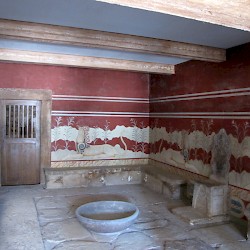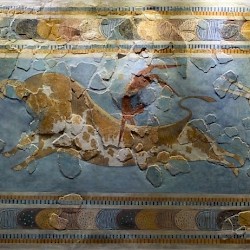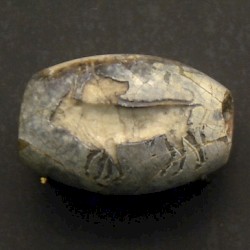Crete
Q34374Crete (Greek Κρήτη, Latin Creta): largest island in Greece.
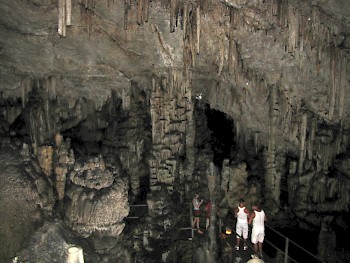
Crete is the island, about 260 kilometer long, "mountainous and thickly wooded",note that separates the Aegean Sea from the eastern basin of the Mediterranean Sea. On this island, there are three mountain ranges: Dicte in the east, Ida in the center, and the White Mountains in the west. Because of the mountains, the island is by nature divided; Homer knew that there were dozens of towns.note The southern shore of the island is rocky and inhospitable for ships, with only a couple of ports (Lissos, Phaestus, Hierapytna) while the northern shore is friendlier and gives access to the plains in the hinterland.
Bronze Age
A place called Kaptara is mentioned for the first time on cuneiform tablets from the Syrian city of Mari, which can be dated to the first half of the eighteenth century BCE. Ugarite sources refer to Kabturi, Egyptian texts mention Keftiu, and the Bible talks about כפתור, "Caphtor". This is usually taken to refer to Crete, although there is no absolute certainty. The least we can say, however, is that it would not be strange if Crete were mentioned in Levantine sources, because the second millennium BCE witnessed the flourishing of the Minoan civilization, named after the mythological king Minos.
 Knossos, Kamares pottery |
 Phaestus, Vase |
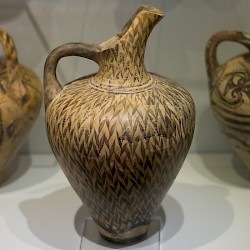 Phaestus, Jar (Reed Painter) |
 Zakros, Pottery |

Modern scholars use two systems to date Minoan finds. The old system, based on the idea that any civilization has stages of growth, splendor, and decline, distinguished Early Minoan (c.3500-c.2100 BCE), Middle Minoan (c.2100-c1600 BCE), and Late Minoan finds (c.1600-1100 BCE). These periods more or less coincide with Egypt's Old, Middle, and New Kingdom. In the other system, four stages are distinguished: before the palaces were built (c.3500-c.1900 BCE), the period of the old palaces (c.1900-c.1750 BCE), the period of the new palaces (c.1750-c.1500 BCE), and the age of Mycenaean domination (c.1500-c.1100 BCE). Both systems have a considerable margin.
The main palaces were Knossos, Phaestus, Malia, (Kato) Zakros, and Galatas; they were rebuilt after a major disturbance, which may have been caused by an earthquake or a foreign invasion. During the New Palace Period, the buildings were again destroyed and rebuilt, perhaps after the eruption of the Thera, which must be dated between 1630 and 1550 BCE. After some three or four generations, the reconstructed palaces were taken over by the Mycenaean Greeks.

There were two main writing systems on Crete: Linear-B was a syllabic script used to write Mycenaean Greek, while Linear-A cannot be deciphered because the number of tablets is too small. (Most tablets are from Agia Triada near Phaestus.) It resembles the Cypro-Minoan script of Cyprus. In Linear-B texts, the island is called Ke-re-te (which does not resemble Egyptian Keftiu). Other names are Ko-no-so and Pa-i-to, Knossos and Phaestus.

Later generations would remember this age and told stories about king Minos and the monster, half bull and half human, that was called Minotaur. The ruins of the palace of Knossos were called the labyrinth, a word that means something like "house of the axes" and may be a very ancient name of the royal residence. Minos was remembered as a great lawgiver and ruler of the seas.note Another story was about the supreme god Zeus, who as a baby was hidden in the Dictaean cave to protect him from the wrath of his father Kronos.note
Archaic and Classical Age
After the collapse of the Bronze Age system in the early twelfth century BCE – commonly labeled the age of the “Sea People” – people retreated from the palaces to the mountains (e.g., Karfi and Lato). Cretan men served as soldiers in the Near East: the Bible mentions a military unit of Keretites serving king David.note Their name closely matches the Linear-B name Ke-re-te.
During the Dark Age (c.1100-c.800 BCE), a new group of people started to dominate Crete: the Dorian Greeks. They may have been immigrants from the north, but it is also possible that they were already on the island in the Mycenaean age, but did not write. In any case, Dorian Greek cannot be derived from the language of the Linear-B tablets.

Archaic society was hierarchical, with a warrior elite that ruled a class of subjects who were working the land. The laws of Gortyn have survived and although they were written down quite late, in the fifth century, they are evidence for this archaic society. The island, divided into some sixty independent political units that were, rather grandiloquently, called poleis, "cities", was unable to play an important role in Greek politics. Knossos and Gortyn were the most important ones and appear to have been quarreling permanently.
The island remained neutral during the Persian,note Archidamian, Decelean, Corinthian, and other wars that divided the Greek world in the fifth and fourth centuries. Still, we find Cretans everywhere: Philip (r.360-336) and Alexander (r.336-323) of Macedonia employed archers from Crete and Alexander's admiral was a Cretan named Nearchus.
Hellenistic Age
After the death of Alexander the Great in 323 BCE, his colonels created kingdoms of their own: the Ptolemaic Empire in Egypt, the Seleucid Empire in Asia, and Macedonia itself. The Ptolemaic rulers were interested in the Greek cities of the Aegean world, which the Antigonid kings of Macedonia considered their backyard. This made the southern part of the Aegean Sea strategically important. Knossos and Gortyn, still rivals, now found allies outside Crete.
At the same time, there were unifying forces. At an unknown moment in the third century BCE, the towns created a Cretan League and in 222 BCE, Gortyn and Knossos concluded a (temporary) alliance that united all of Crete except for a town called Lyttus.note The result was a protracted war, which in turn allowed king Philip V of Macedonia (r.221-179) to gain control. However, after he had lost a war against the Romans, it was king Eumenes II Soter of Pergamon (r.197-159) who concluded an alliance with all towns on Crete (183 BCE). Gortyn now became the most important city.
Roman Age
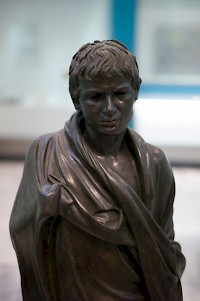
Cretan men remained active abroad as mercenaries. They were still popular as light-armed soldiersnote but are also mentioned among the Cilician Pirates, who invested the Mediterranean Sea in the first third of the first century BCE. After 71, the Roman republic took action against the pirates. The Cretans resisted Marcus Antonius (father of the triumvir), but in 69-67, Quintus Caecilius Metellus invaded and conquered Crete.note
After the Roman civil wars, in which the Cretans supported Brutus, the island became part of the province Crete and Cyrenaica. Knossos received the rank of colonia but the capital was Gortyn.
The Roman age saw a steady rise of prosperity. The island became an independent province when Diocletian (r.284-305) reorganized the empire. Crete was attacked by Vandals in 457, but it was the Arabian attacks in the seventh century that put an end to the island's prosperity; Crete was conquered by the Arabs in c.825 and remained part of the Abbasid Caliphate until it was conquered by the Byzantines in 961.
 Knossos, Relief of Demeter |
 Hierapytna, Hadrian (cast) |
 Gortyn, Temple of the Egyptian deities, Isis-Persephone and Serapis-Hades |
 Chersonessos, Portrait of a young man |
Jewish and Christian Crete
In 58 CE, the apostle Paul sailed along Crete's dangerous southern shorenote and it must have been on that occasion that he appointed Titus as leader of the first Cretan followers of Christ. At that moment, there was a Jewish community on Crete, which was still there in the fifth century. In 448, a messiah named Moses of Crete announced that he would open the Mediterranean Sea and bring back the Jews to Jerusalem, but he failed and some of his followers drowned.note
